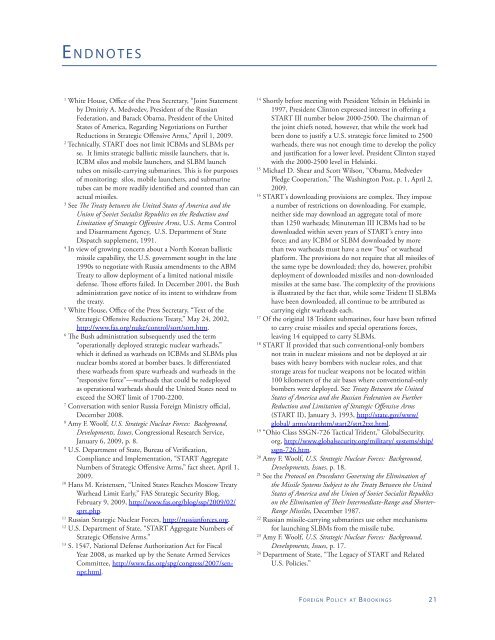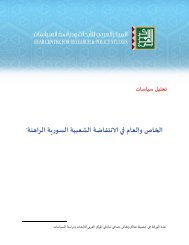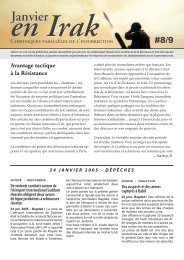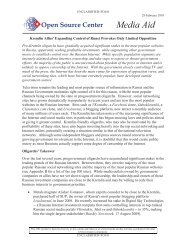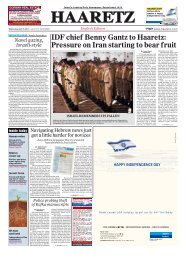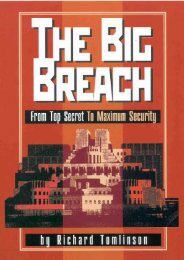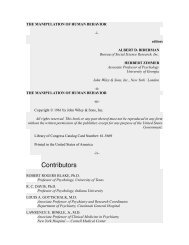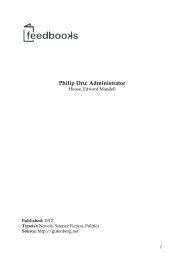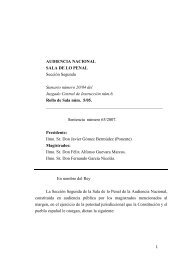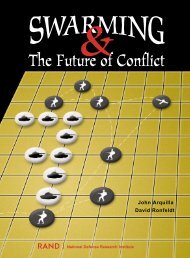Beyond START - Brookings Institution
Beyond START - Brookings Institution
Beyond START - Brookings Institution
Create successful ePaper yourself
Turn your PDF publications into a flip-book with our unique Google optimized e-Paper software.
E n d n o t e s1White House, Office of the Press Secretary, “Joint Statementby Dmitriy A. Medvedev, President of the RussianFederation, and Barack Obama, President of the UnitedStates of America, Regarding Negotiations on FurtherReductions in Strategic Offensive Arms,” April 1, 2009.2Technically, <strong>START</strong> does not limit ICBMs and SLBMs perse. It limits strategic ballistic missile launchers, that is,ICBM silos and mobile launchers, and SLBM launchtubes on missile-carrying submarines. This is for purposesof monitoring: silos, mobile launchers, and submarinetubes can be more readily identified and counted than canactual missiles.3See The Treaty between the United States of America and theUnion of Soviet Socialist Republics on the Reduction andLimitation of Strategic Offensive Arms, U.S. Arms Controland Disarmament Agency, U.S. Department of StateDispatch supplement, 1991.4In view of growing concern about a North Korean ballisticmissile capability, the U.S. government sought in the late1990s to negotiate with Russia amendments to the ABMTreaty to allow deployment of a limited national missiledefense. Those efforts failed. In December 2001, the Bushadministration gave notice of its intent to withdraw fromthe treaty.5White House, Office of the Press Secretary, “Text of theStrategic Offensive Reductions Treaty,” May 24, 2002,http://www.fas.org/nuke/control/sort/sort.htm.6The Bush administration subsequently used the term“operationally deployed strategic nuclear warheads,”which it defined as warheads on ICBMs and SLBMs plusnuclear bombs stored at bomber bases. It differentiatedthese warheads from spare warheads and warheads in the“responsive force”—warheads that could be redeployedas operational warheads should the United States need toexceed the SORT limit of 1700-2200.7Conversation with senior Russia Foreign Ministry official,December 2008.8Amy F. Woolf, U.S. Strategic Nuclear Forces: Background,Developments, Issues, Congressional Research Service,January 6, 2009, p. 8.9U.S. Department of State, Bureau of Verification,Compliance and Implementation, “<strong>START</strong> AggregateNumbers of Strategic Offensive Arms,” fact sheet, April 1,2009.10Hans M. Kristensen, “United States Reaches Moscow TreatyWarhead Limit Early,” FAS Strategic Security Blog,February 9, 2009, http://www.fas.org/blog/ssp/2009/02/sprt.php.11Russian Strategic Nuclear Forces, http://russianforces.org.12U.S. Department of State, “<strong>START</strong> Aggregate Numbers ofStrategic Offensive Arms.”13S. 1547, National Defense Authorization Act for FiscalYear 2008, as marked up by the Senate Armed ServicesCommittee, http://www.fas.org/spg/congress/2007/sennpr.html.14Shortly before meeting with President Yeltsin in Helsinki in1997, President Clinton expressed interest in offering a<strong>START</strong> III number below 2000-2500. The chairman ofthe joint chiefs noted, however, that while the work hadbeen done to justify a U.S. strategic force limited to 2500warheads, there was not enough time to develop the policyand justification for a lower level. President Clinton stayedwith the 2000-2500 level in Helsinki.15Michael D. Shear and Scott Wilson, “Obama, MedvedevPledge Cooperation,” The Washington Post, p. 1, April 2,2009.16<strong>START</strong>’s downloading provisions are complex. They imposea number of restrictions on downloading. For example,neither side may download an aggregate total of morethan 1250 warheads; Minuteman III ICBMs had to bedownloaded within seven years of <strong>START</strong>’s entry intoforce; and any ICBM or SLBM downloaded by morethan two warheads must have a new “bus” or warheadplatform. The provisions do not require that all missiles ofthe same type be downloaded; they do, however, prohibitdeployment of downloaded missiles and non-downloadedmissiles at the same base. The complexity of the provisionsis illustrated by the fact that, while some Trident II SLBMshave been downloaded, all continue to be attributed ascarrying eight warheads each.17Of the original 18 Trident submarines, four have been refittedto carry cruise missiles and special operations forces,leaving 14 equipped to carry SLBMs.18<strong>START</strong> II provided that such conventional-only bombersnot train in nuclear missions and not be deployed at airbases with heavy bombers with nuclear roles, and thatstorage areas for nuclear weapons not be located within100 kilometers of the air bases where conventional-onlybombers were deployed. See Treaty Between the UnitedStates of America and the Russian Federation on FurtherReduction and Limitation of Strategic Offensive Arms(<strong>START</strong> II), January 3, 1993, http://state.gov/www/global/ arms/starthtm/start2/strt2txt.html.19“Ohio Class SSGN-726 Tactical Trident,” GlobalSecurity.org, http://www.globalsecurity.org/military/ systems/ship/ssgn-726.htm.20Amy F. Woolf, U.S. Strategic Nuclear Forces: Background,Developments, Issues, p. 18.21See the Protocol on Procedures Governing the Elimination ofthe Missile Systems Subject to the Treaty Between the UnitedStates of America and the Union of Soviet Socialist Republicson the Elimination of Their Intermediate-Range and Shorter-Range Missiles, December 1987.22Russian missile-carrying submarines use other mechanismsfor launching SLBMs from the missile tube.23Amy F. Woolf, U.S. Strategic Nuclear Forces: Background,Developments, Issues, p. 17.24Department of State, “The Legacy of <strong>START</strong> and RelatedU.S. Policies.”Fo r e i g n P o l i c y at Bro o k i n g s 21


